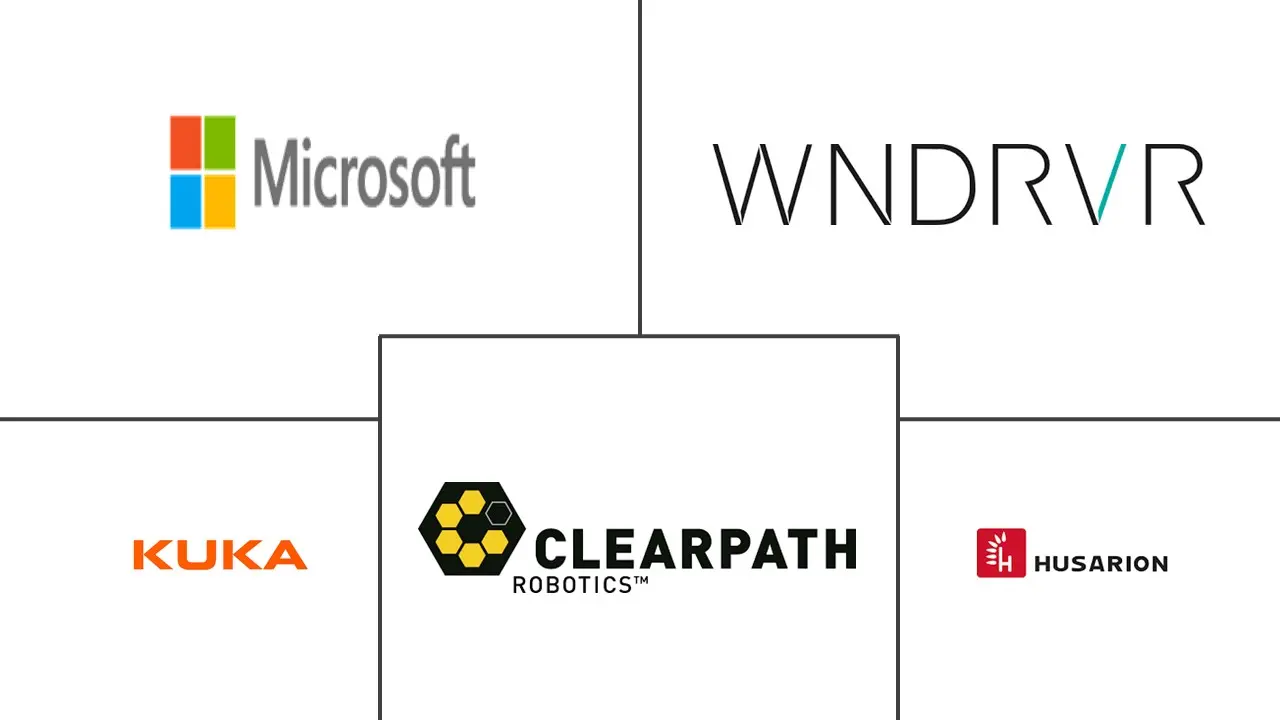Robot Operating System Market Size and Share
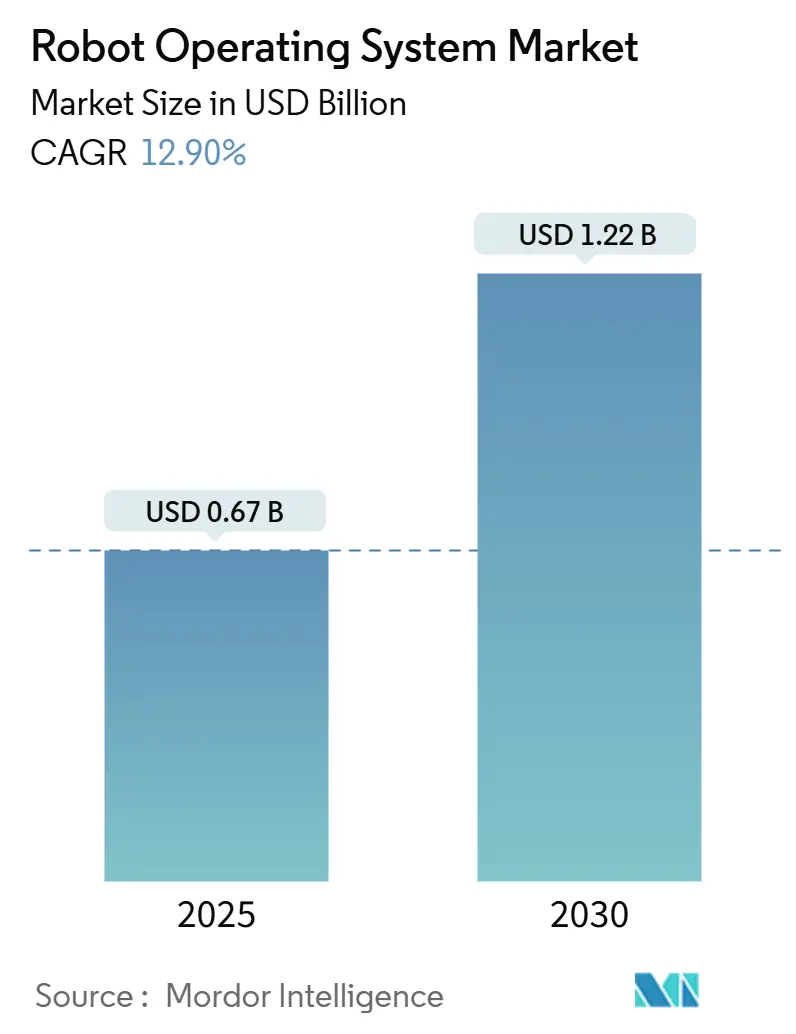
Robot Operating System Market Analysis by Mordor Intelligence
The robot operating system market size is estimated at USD 0.67 billion in 2025 and is forecast to reach USD 1.22 billion by 2030, advancing at a 12.9% CAGR. Growth stems from rising industrial automation, wider interoperability requirements, and the shift toward open, modular software that lets robots adapt to changing floor-shop conditions without extensive re-engineering. Advances in edge computing and 5G are pulling real-time control closer to the robot, while cloud simulation and Robot-as-a-Service models lower entry barriers for firms new to robotics. The wide availability of ROS-Industrial libraries is standardizing motion, perception, and safety functions, accelerating deployment times. Automotive, electronics, and healthcare producers are leading adopters because they balance high volumes with a need for flexible tooling. Platform vendors that bundle long-term support, security hardening, and update orchestration are carving out premium service positions as ROS 1 approaches end-of-life in May 2025.
Key Report Takeaways
- By robot type, industrial robots held 57% of the Robot operating system market share in 2024, while service robots are projected to expand at a 16.8% CAGR through 2030.
- By end-user industry, automotive accounted for 24% of the Robot operating system market size in 2024; healthcare is advancing at a 15.91% CAGR to 2030.
- By component, the software stack commanded 68% of the Robot operating system market size in 2024, with integration and support services forecast to grow at 14.5% CAGR.
- By deployment mode, on-premises solutions captured 74% of 2024 revenue; cloud deployments are scaling at a 21% CAGR.
- By operating-system distribution, ROS 1 retained a 62% share in 2024, even as ROS 2 adoption is rising at a 15.21% CAGR.
- By hardware architecture support, ROS 1 retained 62% share in 2024 even as ROS 2 adoption is rising at a 15.21% CAGR.
- By geography, Asia-Pacific led with a 38% revenue share in 2024, whereas the Middle East is projected to post the fastest 17.1% CAGR through 2030.
Global Robot Operating System Market Trends and Insights
Drivers Impact Analysis
| Driver | (~) % Impact on CAGR Forecast | Geographic Relevance | Impact Timeline |
|---|---|---|---|
| ROS-enabled cobots in automotive lines | +2.5% | China, Japan, South Korea | Medium term (2-4 years) |
| Expansion of cloud-based simulation platforms | +2.1% | North America, Europe | Short term (≤ 2 years) |
| Government-funded robotics testbeds | +1.8% | Asia-Pacific, Middle East | Medium term (2-4 years) |
| Integration of ROS 2 with 5G and edge-AI for AMRs | +2.7% | Global (early uptake in NA & EU) | Medium term (2-4 years) |
| Source: Mordor Intelligence | |||
Growing Adoption of ROS-enabled Cobots in Automotive Assembly Lines
Automotive groups are boosting collaborative-robot deployment to improve takt times and address skilled-labour gaps. Volkswagen, General Motors, and Tesla have integrated ROS-based cobots for gluing, inspection, and screw-fastening tasks, lifting station throughput and maintaining high first-pass yields. Stellantis demonstrated a 27% assembly-efficiency gain by synchronizing mobile manipulators with augmented-reality guidance and digital-twin feedback at its Mirafiori plant. Cobots configured with ROS 2 benefit from DDS middleware, which removes single points of failure and enables live safety-parameter updates. Growth remains linked to falling sensor costs and plug-and-play tooling that cuts integration time for mixed-model lines.
Expansion of Cloud-based Simulation Platforms
Industrial developers increasingly validate full robot workloads in virtual environments before placing hardware on a factory floor. The FogROS2-FT framework offloads compute-heavy motion-planning queries to multiple cloud endpoints, reducing simulation costs by 2.2× and strengthening fault tolerance. AWS RoboMaker and similar services attach continuous-integration hooks, so each code commit triggers automated regression tests, shortening development sprints. Developers use these pipelines to iterate perception and grasping algorithms without halting physical production lines, accelerating go-live timelines for new SKUs. [1]Kaiyuan Chen et al., “FogROS2-FT: Fault Tolerant Cloud Robotics,” autolab.berkeley.edu
Surge in Government-Funded Robotics Testbeds
Public agencies across the UAE, Saudi Arabia, South Korea, and Singapore fund open testbeds that pool advanced sensors, AMR fleets, and 5G connectivity. Start-ups gain access to certified safety zones and mentorship, reducing compliance hurdles when scaling pilots into commercial deployments. These initiatives prioritize ROS 2 so academic prototypes transition smoothly into industrial settings, lifting ecosystem maturity and drawing component suppliers into regional hubs.
Integration of ROS 2 with 5G and Edge-AI for AMRs
The OROS orchestration stack coordinates network slices and off-loads perception tasks to edge servers, cutting AMR CPU load while sustaining sub-millisecond latency for obstacle avoidance. Field tests show longer battery life and tighter delivery windows. Hardware partners such as ADLINK pair NVIDIA Jetson-based controllers with ROS 2 to run simultaneous localization, AI inferencing, and fleet-management services on the same board.
Restraints Impact Analysis
| Restraint | (~) % Impact on CAGR Forecast | Geographic Relevance | Impact Timeline |
|---|---|---|---|
| Cyber-security vulnerabilities in distributed ROS nets | -1.7% | Global (highest in automation-dense regions) | Medium term (2-4 years) |
| Scarcity of certified ROS talent in emerging markets | -1.9% | Southeast Asia, Latin America, Africa | Medium term (2-4 years) |
| Source: Mordor Intelligence | |||
Cyber-Security Vulnerabilities in Distributed ROS Networks
ROS 1 nodes rely on unencrypted TCPROS topics that can be spoofed or replayed, exposing safety-critical actuators. Although ROS 2 embeds authentication and access-control plugins through DDS, misconfigurations remain common when fleets span multiple VLANs. Recent penetration tests revealed weak certificate management in healthcare robotics deployments, prompting operators to institute zero-trust policies, segmented networks, and real-time anomaly detection. Industry consortia now issue hardening guides, yet small and medium manufacturers often lack cyber-security personnel to apply recommended patches.
Scarcity of Certified ROS Talent in Emerging Markets
A survey of 100 robotics professionals found 95.1% awareness of ROS 2 but limited project adoption because teams depend on ROS 1 packages and lack migration expertise. Growing demand outpaces the throughput of university programs, with particular shortages in Latin America and Southeast Asia. Enterprises respond by sponsoring fast-track bootcamps and engaging the ROS-Industrial Consortium for on-site upskilling sessions. Talent scarcity extends project timelines and raises integration costs, especially when safety certifications require experienced developers.
Segment Analysis
By Robot Type: Industrial Robots Lead While Service Segment Accelerates
Industrial robots contributed 57% of 2024 revenue, reflecting long-established use in welding, palletizing, and CNC tending tasks. FANUC’s one-millionth unit milestone underscores the scale and installed base maturity. Within that cohort, cobots represent one-quarter of automotive deployments, highlighting the push toward human-machine collaboration on mixed-model lines. Service robots, particularly logistics AMRs and hospital couriers, are set to post a 16.8% CAGR through 2030, propelled by e-commerce fulfilment pressures and patient-care quality initiatives.
Service-segment momentum is evident in rising deployments of navigation-ready platforms paired with AI vision for shelf-restocking and autonomous cleaning. Vendors leverage ROS 2’s real-time quality-of-service settings to keep SLAM maps consistent across large facilities. The Robot operating system market size for service units serving professional environments is forecast to expand rapidly as subscription pricing aligns with facility-management budgets. Industrial manufacturers increasingly bundle analytics dashboards, adding predictive-maintenance overlays that sharpen uptime metrics.
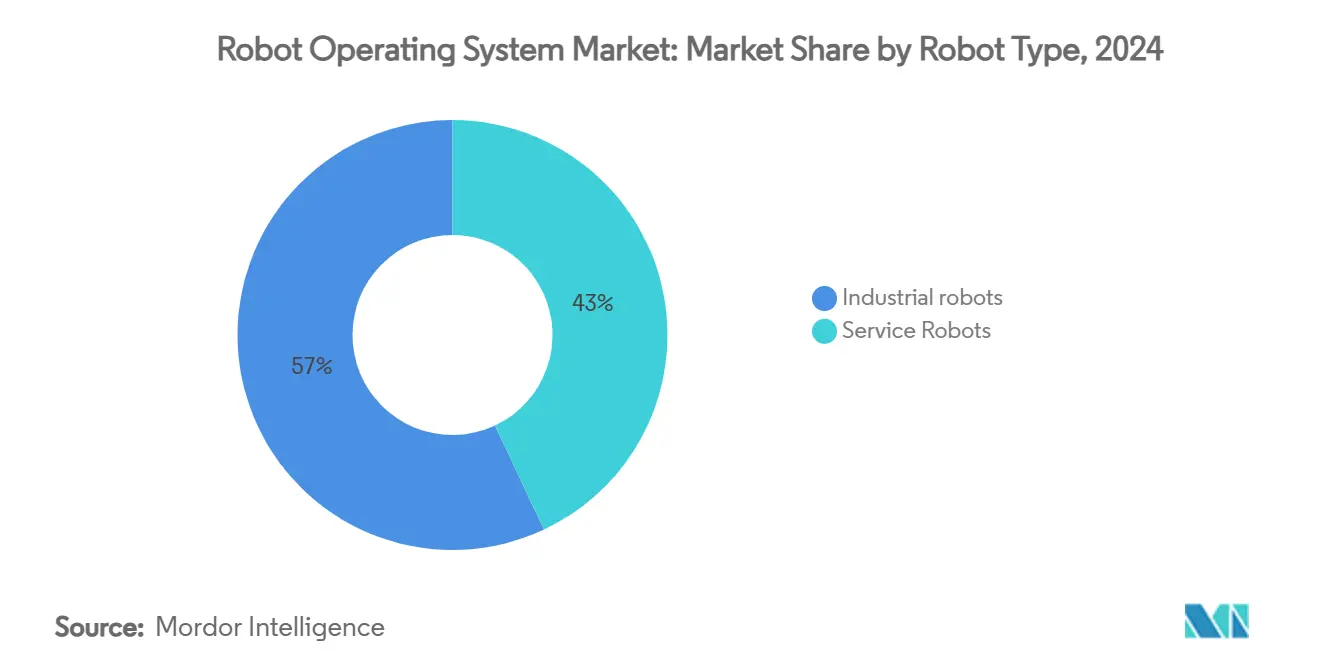
By End-user Industry: Automotive Dominates While Healthcare Surges
Automotive producers accounted for a commanding 24% slice of 2024 revenue, using ROS-based motion planning and quality-inspection pipelines to manage higher model variants without line stoppages. Hexapod alignment systems support headlamp calibration and optical-sensor positioning needed for driver-assistance features. Connected automated vehicle demonstrators further show how AMR tuggers synchronized by ROS 2 can replenish parts bins just-in-time, lifting throughput across end-of-line stations.
Healthcare records the steepest ascent with a 15.91% CAGR. ROS-based surgical assistants employ deterministic loop timing to coordinate multi-axis tool paths, meeting stringent kinematic accuracy targets. Hospital logistics platforms such as PeTRA combine ROS 2 with advanced HRI modules to navigate crowds and respond to patient vitals in real time. As providers digitize operating rooms, the Robot operating system market size for healthcare robotics is expected to broaden into diagnostics and rehabilitation.
By Component: Software Stack Remains Core While Services Expand
Core libraries, middleware, and visualization tools represented 68% of 2024 spending, confirming software as the value anchor in a system where hardware increasingly commoditizes. Migration to ROS 2 drives demand for deterministic executors, Real-Time Linux kernels, and DDS implementations tuned for mixed-criticality workloads. The arrival of ROS2WASM extends reach into browser-based simulation so engineering teams can prototype multi-robot scenarios without local installs.
Integration and support services follow with 14.5% CAGR as manufacturers seek turnkey stacks, safety validation, and OTA update schemes. Consortium-backed reference architectures shorten path-to-production by stacking perception, planning, and control building blocks. Vendors secure recurring revenue via long-term support contracts that guarantee patch availability well beyond ROS 1 sunset, reinforcing the Robot operating system market’s preference for enterprise-grade assurances.
By Operating System Distribution: ROS 1 Legacy Persists as ROS 2 Gains Momentum
Despite an official sunset slated for May 2025, ROS 1 still powered 62% of live systems in 2024 because entrenched code bases and stable APIs keep maintenance overhead predictable. Long-term support forks reassure plants with decade-long asset cycles. Transition roadmaps often involve running ROS 1 and ROS 2 bridges during phased module swaps to protect uptime.
ROS 2 advances at a 15.21% CAGR thanks to its peer-to-peer architecture, security extensions, and native multi-robot scheduling. The ROS-Industrial Consortium streamlines adoption through reference stacks that merge perception, grasp planning, and compliant control, enabling factories to repurpose robots without offline re-programming. As extension ecosystems mature, the Robot Operating System market is poised for a tipping point where new deployments default to ROS 2.
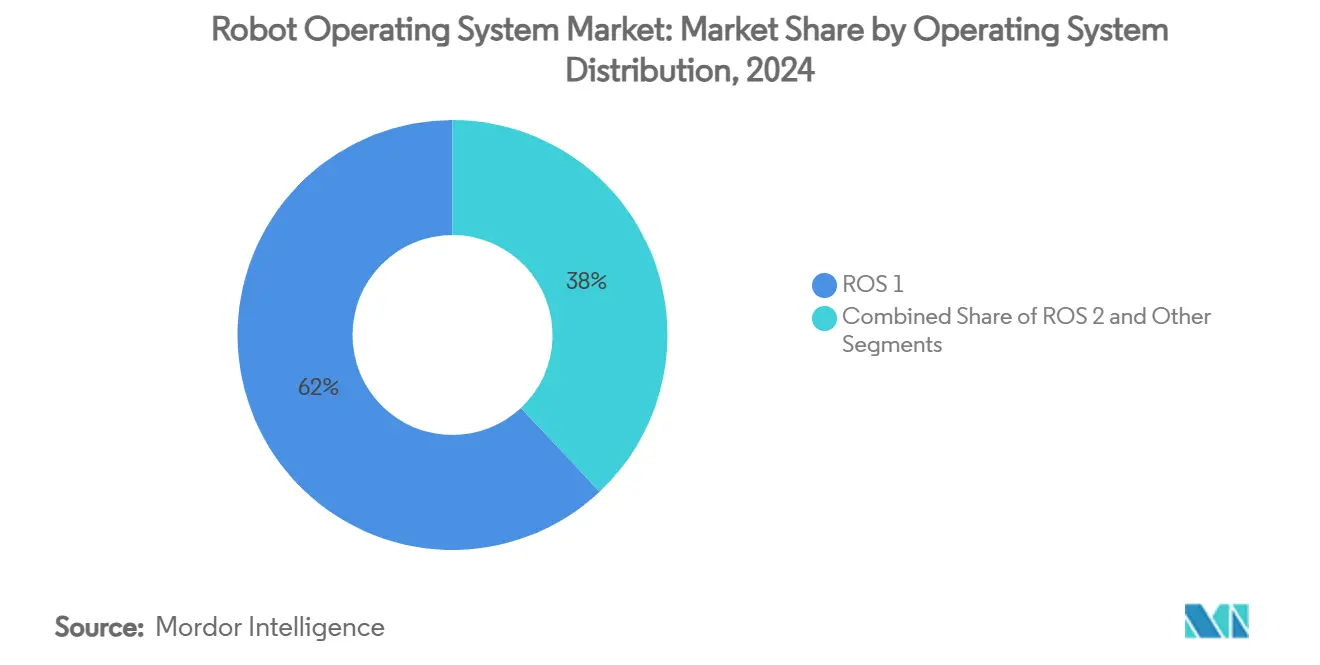
Note: Segment shares of all individual segments available upon report purchase
By Deployment Mode: On-premises Prevails While Cloud Accelerates
Local installations still hold 74% of total revenue because deterministic control loops and IP-sensitive processes favour internal hosting. Tier-1 automotive plants often co-locate ROS nodes with PLCs to eliminate network jitter. Yet cloud adoption registers a robust 21% CAGR as Robot-as-a-Service lowers upfront capital outlays. FogROS2-FT shows that splitting compute across multiple cloud providers maintains real-time constraints while reducing operating expense by more than twofold.
Fleet-management suites such as AWS IoT RoboRunner harmonize heterogeneous robot swarms across sites, letting retailers unify traffic rules and charge scheduling. Combined with dynamic simulation, users can clone a facility’s digital twin, test workflow changes overnight, and push updates before a line shift starts. The Robot operating system market’s cloud cohort is projected to benefit further from 5G SA rollouts that cut backhaul latency.
Geography Analysis
Asia-Pacific held 38% of global revenue in 2024 due to heavy automation investment in China, Japan, and South Korea. Shanghai’s ROSCon China attracted more than 200 firms, signifying local community depth. Government funding accelerates adoption: South Korea’s Tech Valley subsidies underwrite AI inference accelerators for small-batch electronics plants, while Singapore’s ART C testbeds trial advanced 3D vision libraries. The Robot operating system market size in the region is projected to keep pace as domestic suppliers extend low-cost arms into ASEAN manufacturing corridors.
The Middle East records the fastest 17.1% CAGR through 2030. National programs such as Saudi Arabia’s Vision 2030 and the UAE’s Operation 300bn lean on robotics to diversify away from hydrocarbons. Government-backed demonstration zones in Dubai simplify regulatory compliance, allowing rapid pilot launch for warehouse and surgical robots. Regional system integrators partner with European component makers to localize supply chains, reinforcing self-sufficiency goals.
North America remains an innovation nucleus, hosting core ROS maintainers and hyperscale cloud providers. The ROS-Industrial Consortium Americas showcases open-source quality-assurance pipelines to a membership spanning aerospace, oil & gas, and food processing. Universities funnel research on adaptive manipulation into spin-offs that secure venture capital, sustaining a rich start-up pipeline. Demand is further buoyed by reshoring initiatives and tax incentives for advanced manufacturing equipment.
Europe combines strong industrial-robot density with government mandates for cyber-secure automation. Germany alone houses one-third of Europe’s installed base and pushes ROS-based retrofits as part of its Industrie 4.0 framework. Countries such as Spain and Hungary logged double-digit robot-stock growth in 2024. Conferences in Odense underscore collaborative R&D, linking Danish cobot makers with AI researchers to commercialize adaptive pick-and-place functions.
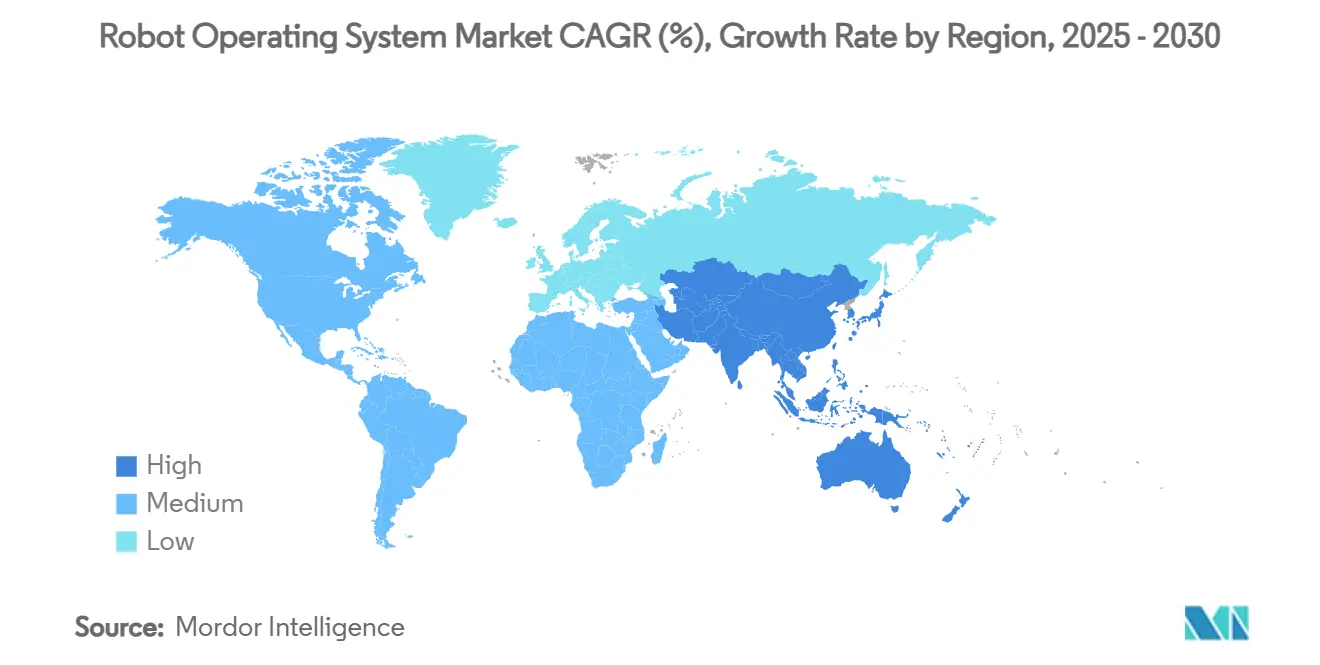
Competitive Landscape
The Robot operating system market features a moderately fragmented structure where open-source stewards sit alongside hardware OEMs and specialized integrators. Open Robotics, now part of Alphabet’s Intrinsic, governs the core codebase, issuing release roadmaps and compatibility guidelines. Commercial vendors differentiate by bundling certified distributions, real-time patches, and long-term support packages that enterprises demand for safety-critical operations.
Partnerships with AI accelerators shape competitive edge. NVIDIA collaborates with BYD Electronics, Siemens, Teradyne Robotics, and Intrinsic to embed its Jetson and Isaac SDK into ROS-based machines, enabling GPU-accelerated perception and motion-planning stacks. Cogniteam’s integration of RTI Connext strengthens cloud fleet-management latency and QoS for mixed vendor fleets.
Vertical specialization yields new entrants. Southwest Research Institute’s USD 6.7 million contract with the U.S. Air Force targets a multiprocessor robotic cell for aircraft maintenance that leverages ROS 2 to choreograph sanding, drilling, and inspection tasks. In healthcare, AMD’s FPGA-enhanced Kria SOM speeds real-time visualization loops for surgical robotics, granting integrators a certified compute platform. The competitive narrative continues to reward players that fuse domain knowledge with open middleware, letting customers avoid vendor lock-in while meeting sector-specific standards. [2]NVIDIA, “NVIDIA Robotics Adopted by Industry Leaders for Development of Tens of Millions of AI-Powered Autonomous Machines,” nvidianews.nvidia.com
Robot Operating System Industry Leaders
-
Microsoft Corporation
-
Amazon Web Services Inc.
-
Clearpath Robotics Inc.
-
KUKA AG
-
Bosch Rexroth AG
- *Disclaimer: Major Players sorted in no particular order
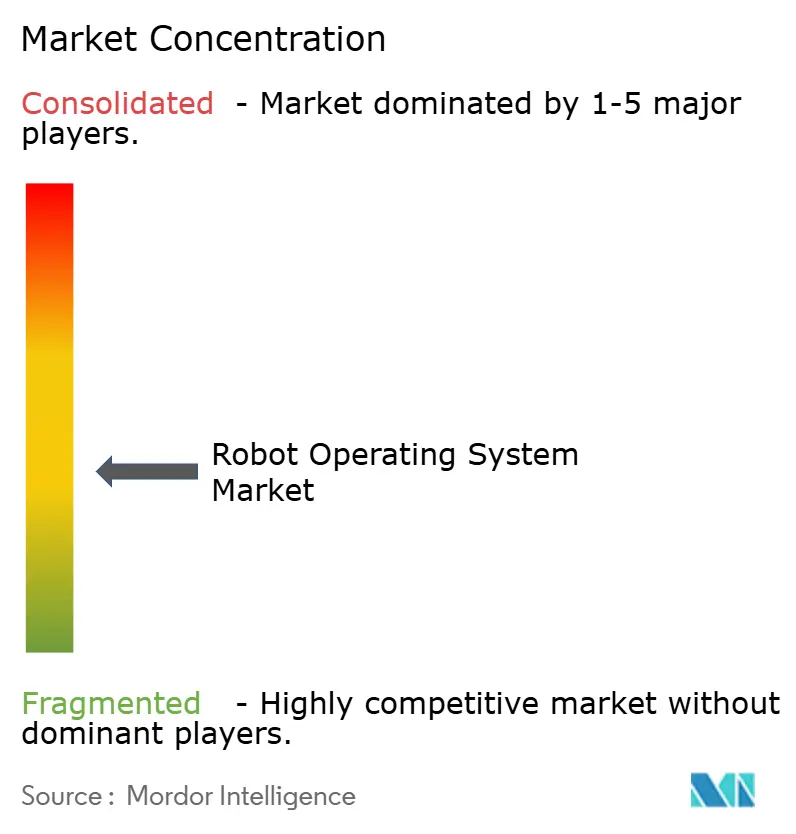
Recent Industry Developments
- March 2025: Mitsubishi Electric released a ROS 2 driver for MELFA robots, easing flexible-automation integration.
- March 2025: NVIDIA introduced the Isaac platform for healthcare, adding biomechanical simulation capabilities.
- February 2025: ABB outlined three robotics growth levers—dynamic autonomy, sector expansion, and workforce upskilling—to ease adoption barriers.
- January 2025: The International Federation of Robotics reported that industrial robot installations reached USD 16.5 billion, spotlighting AI integration, humanoid prototypes, and new service models.
Global Robot Operating System Market Report Scope
Robot Operating System is a powerful and flexible open-source framework that enables software development for robotic systems. Geography segments the robot OS market. The report covers a detailed analysis of ROS covering all the market insights, including Porters Integrated solutions offered by vendors of robotic systems that are not considered in the scope of the study.
The Robot Operating System Market is segmented by Type (Industrial, Commercial), End-User Industry (Manufacturing, Healthcare, Aerospace & Defense), and Geography.
| Industrial Robots | Articulated | |
| SCARA | ||
| Parallel/Delta | ||
| Cartesian/Linear | ||
| Collaborative Robots (Cobots) | ||
| Service Robots | Professional Service Robots | Logistics Robots |
| Healthcare and Medical Robots | ||
| Defense and Security Robots | ||
| Agricultural Robots | ||
| Personal and Domestic Service Robots | ||
| Automotive |
| Electrical and Electronics |
| Healthcare and Life Sciences |
| E-commerce and Logistics |
| Aerospace and Defense |
| Food and Beverage |
| Agriculture |
| Education and Research |
| Others (Metal, Plastics, etc.) |
| Software Stack | Core ROS Libraries |
| Middleware / Communication Tools | |
| Simulation & Visualization (Gazebo, RViz) | |
| Services | System Integration and Consulting |
| Support and Maintenance | |
| Training and Certification |
| ROS 1 |
| ROS 2 |
| Other Variants (ROS-Industrial, micro-ROS) |
| x86 |
| ARM |
| RISC-V and Others |
| On-premise |
| Cloud-based (ROS-aaS) |
| North America | United States |
| Canada | |
| Mexico | |
| South America | Brazil |
| Argentina | |
| Rest of South America | |
| Europe | Germany |
| United Kingdom | |
| France | |
| Italy | |
| Spain | |
| Rest of Europe | |
| Nordics | Sweden |
| Norway | |
| Denmark | |
| Finland | |
| Iceland | |
| Middle East | GCC |
| Turkey | |
| Rest of Middle East | |
| Africa | South Africa |
| Rest of Africa | |
| Asia-Pacific | China |
| Japan | |
| South Korea | |
| India | |
| Indonesia | |
| Rest of Asia-Pacific |
| By Robot Type | Industrial Robots | Articulated | |
| SCARA | |||
| Parallel/Delta | |||
| Cartesian/Linear | |||
| Collaborative Robots (Cobots) | |||
| Service Robots | Professional Service Robots | Logistics Robots | |
| Healthcare and Medical Robots | |||
| Defense and Security Robots | |||
| Agricultural Robots | |||
| Personal and Domestic Service Robots | |||
| By End-user Industry | Automotive | ||
| Electrical and Electronics | |||
| Healthcare and Life Sciences | |||
| E-commerce and Logistics | |||
| Aerospace and Defense | |||
| Food and Beverage | |||
| Agriculture | |||
| Education and Research | |||
| Others (Metal, Plastics, etc.) | |||
| By Component | Software Stack | Core ROS Libraries | |
| Middleware / Communication Tools | |||
| Simulation & Visualization (Gazebo, RViz) | |||
| Services | System Integration and Consulting | ||
| Support and Maintenance | |||
| Training and Certification | |||
| By Operating System Distribution | ROS 1 | ||
| ROS 2 | |||
| Other Variants (ROS-Industrial, micro-ROS) | |||
| By Hardware Architecture Support | x86 | ||
| ARM | |||
| RISC-V and Others | |||
| By Deployment Mode | On-premise | ||
| Cloud-based (ROS-aaS) | |||
| By Geography | North America | United States | |
| Canada | |||
| Mexico | |||
| South America | Brazil | ||
| Argentina | |||
| Rest of South America | |||
| Europe | Germany | ||
| United Kingdom | |||
| France | |||
| Italy | |||
| Spain | |||
| Rest of Europe | |||
| Nordics | Sweden | ||
| Norway | |||
| Denmark | |||
| Finland | |||
| Iceland | |||
| Middle East | GCC | ||
| Turkey | |||
| Rest of Middle East | |||
| Africa | South Africa | ||
| Rest of Africa | |||
| Asia-Pacific | China | ||
| Japan | |||
| South Korea | |||
| India | |||
| Indonesia | |||
| Rest of Asia-Pacific | |||
Key Questions Answered in the Report
What is the current value of the Robot operating system market?
The market stands at USD 0.67 billion in 2025 and is projected to reach USD 1.22 billion by 2030
Which region leads adoption of ROS-based robots?
Asia-Pacific leads with a 38% revenue share thanks to large-scale manufacturing investment across China, Japan, and South Korea.
Why is ROS 2 gaining traction over ROS 1?
ROS 2 offers real-time quality-of-service, built-in security through DDS, and peer-to-peer node discovery, features that address ROS 1’s latency and cybersecurity limitations.
How fast are cloud-based ROS deployments growing?
Cloud deployments are advancing at a 21% CAGR as Robot-as-a-Service models cut initial capital spending and support remote fleet management.
Which end-user vertical shows the fastest growth?
Healthcare is expanding at a 15.91% CAGR as surgical, rehabilitation, and hospital logistics robots leverage ROS 2 for deterministic control and safe human-robot interaction.
Will ROS 1 still be supported after 2025?
Mainstream support ends in May 2025, but several vendors will maintain long-term service branches so plants with legacy code can schedule phased migrations without operational risk.
Page last updated on:
